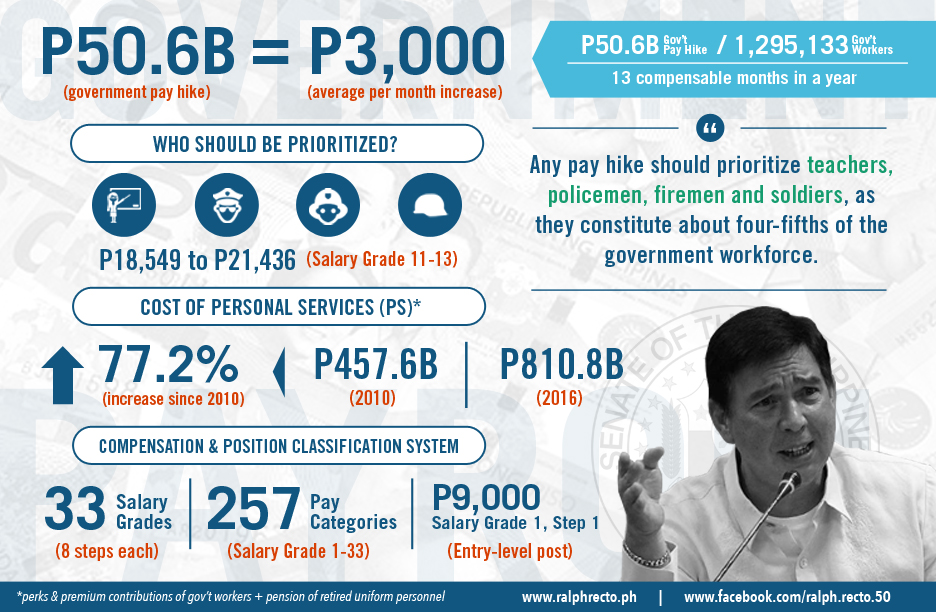P50.6 B for gov’t pay hike translates into an average P3,000 monthly increase
The national government is setting aside P50.6 billion in the proposed 2016 national budget for the salary hike of its 1.3 million workers, details of which will be fleshed out in a bill the Palace will later send to Congress.
Although the Palace is still mum on the bill’s particulars, Sen. Ralph Recto said that the money being sought for the pay hike “translates into an average P3,000 monthly increase per employee.”
Recto arrived at the figure by dividing the proposed P50.6 billion by 1,295,056 employees in the government payroll and using 13 compensable months in a year.
“I think a P3,000 average per month increase is the floor being sought. And I have to stress the fact that I am using an average here. It may not also be uniform kasi iba-iba ang rates ng sweldo, Recto said.
“Secondly, I am assuming a January starting date. So if the increase would take effect July, then we’re looking at an average P6,000 monthly adjustment. Kaya nga maraming variables,” Recto said.
Recto said it is also possible that the mulled pay hike in 2016 “may just be the first installment of a bigger pay adjustment that will be implemented in phases.”
He recalled that in the initial implementation of Salary Standardization Law (SSL) III, the public sector pay guide in current use was spread out over four years.
Department of Budget and Management (DBM) Secretary Florencio Abad confirmed before senators today that his agency is drafting an SSL IV based on a commissioned study on the state of public sector pay.
Recto urged the DBM to submit the bill as soon as possible so it can be tackled “in unison” with the national budget.
“You can’t divorce the two. 27centavos for every budget peso in 2016 is for PS,” Recto said, referring to Personal Services, the budgeting term for the “pay, perks and premium contributions of government workers and the pension of retired uniformed personnel.”
“There is also the need to subject the proposal to feedback and consultation from stakeholders, like government employees,” Recto said.
“Kung ano man ang numero, dapat pag-aralan kung sapat ba ito o kulang?” Recto said.
“One critical aspect is the funding – clear sources of funds must be identified. It is easy to pick a figure. The challenge is to raise the cash to fund the increase,” he said.
Recto said PS expenses of the government will hit P810 billion in 2016, from this year’s adjusted figure of P745 billion.
“We’re going to spend P2.2 billion a day for PS next year,” he said.
Recto reiterated his call that any pay hike should prioritize teachers, policemen, firemen and soldiers, as they constitute about four-fifths of the government workforce.
“Ito ‘yung Police Officer 1, Teacher 1, Firemen 1. They’re mostly clustered around the Salary Grade 11 to 13 brackets. They get a basic monthly pay of between P18,549 to P21,436. These are the people who are in need of a salary hike,” he said.
At present, the government’s “Compensation and Position Classification System” has 33 salary grades. Except for Grade 33, which is occupied by one person, the President, each salary grade has eight steps.
“So there are a total of 257 pay categories which must be studied and adjusted. There must be distinctions and differentiation between and within the salary grades,” Recto said.
“What makes the job harder is that all of these 257 pay categories must be accommodated within a ceiling, which at present is P120,000 a month–the salary the President gets,” he explained.
At the other end of the spectrum is the P9,000 monthly salary of a Salary Grade 1, Step 1 holder, the entry-level post in government.
PS costs have grown by 77.2 percent from P457.6 billion in 2010 to next year’s proposed P810.8 billion level.


